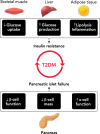Circadian Etiology of Type 2 Diabetes Mellitus
- PMID: 29412061
- PMCID: PMC5899235
- DOI: 10.1152/physiol.00003.2018
Circadian Etiology of Type 2 Diabetes Mellitus
Abstract
The epidemic of Type 2 diabetes mellitus necessitates development of novel therapeutic and preventative strategies to attenuate expansion of this debilitating disease. Evidence links the circadian system to various aspects of diabetes pathophysiology and treatment. The aim of this review will be to outline the rationale for therapeutic targeting of the circadian system in the treatment and prevention of Type 2 diabetes mellitus and consequent metabolic comorbidities.
Figures


References
-
- Andrews JL, Zhang X, McCarthy JJ, McDearmon EL, Hornberger TA, Russell B, Campbell KS, Arbogast S, Reid MB, Walker JR, Hogenesch JB, Takahashi JS, Esser KA. CLOCK and BMAL1 regulate MyoD and are necessary for maintenance of skeletal muscle phenotype and function. Proc Natl Acad Sci USA 107: 19090–19095, 2010. doi:10.1073/pnas.1014523107. - DOI - PMC - PubMed
-
- Atger F, Gobet C, Marquis J, Martin E, Wang J, Weger B, Lefebvre G, Descombes P, Naef F, Gachon F. Circadian and feeding rhythms differentially affect rhythmic mRNA transcription and translation in mouse liver. Proc Natl Acad Sci USA 112: E6579–E6588, 2015. doi:10.1073/pnas.1515308112. - DOI - PMC - PubMed
Publication types
MeSH terms
Grants and funding
LinkOut - more resources
Full Text Sources
Other Literature Sources
Medical

